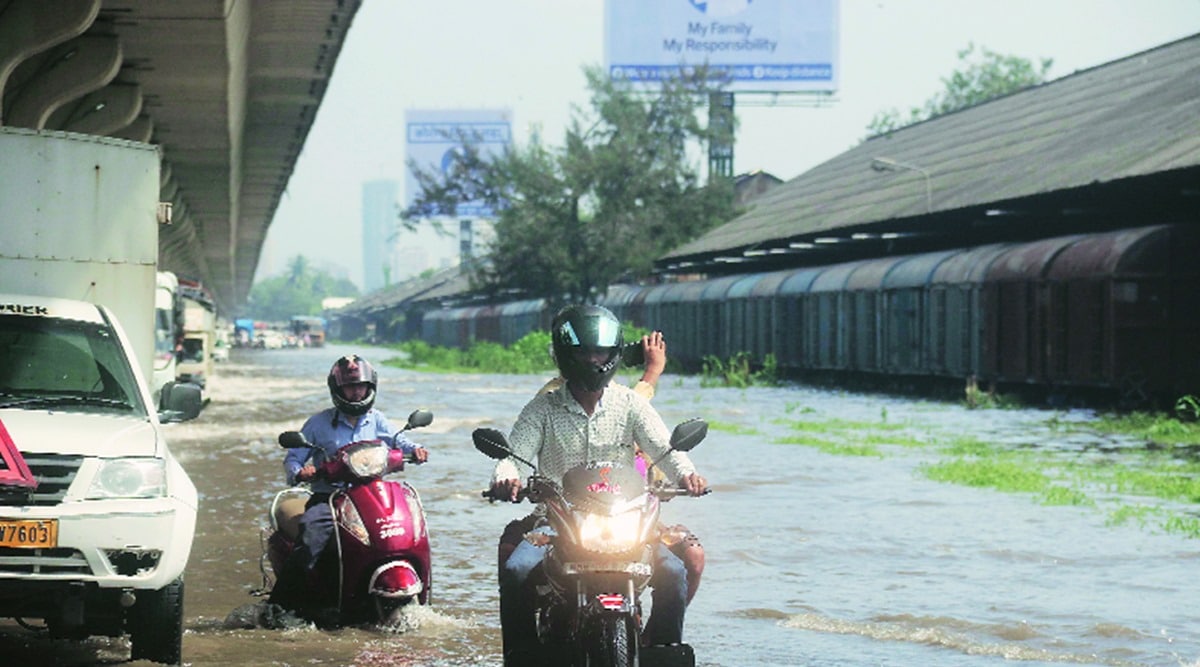 Motorists drive on a waterlogged road in Reay Road area on Thursday. (Photo by Ganesh Shirsekar)
Motorists drive on a waterlogged road in Reay Road area on Thursday. (Photo by Ganesh Shirsekar)The torrential rain in Mumbai caused unprecedented flooding in various parts of the city. However, unlike in the past, this year’s monsoon rain seems to have breached new frontiers with the emergence of new flooding spots than those that are known to get inundated during a downpour.
According to civic officials, areas like Lamington Road, Nair hospital, Agripada, Chinchpokli, Lalbaug, Worli Seaface and Worli BDD Chawl were among the new waterlogging spots.
Besides these areas, the chronic flooding spots and low-lying areas like Nana Chowk, Mumbai Central, Hindmata, Parel and Gandhi Market remained flooded for a long time as water receded slowly. According to BMC data as on May 30, there were 115 waterlogging spots in the city. However, on Wednesday waterlogging was witnessed in areas not notified as problem areas.
Speaking to The Indian Express, Deputy Municipal Commissioner (Zone 1) Harshad Kale said, “Our team from stormwater drain and solid waste management departments are inspecting the flooding sites.”
Officials said between Tuesday night and Wednesday morning rainfall was high and there was a high tide at 4 am. “After the high tide floodgates of pumping stations were shut to prevent seawater from entering city’s drains. And rainwater was pumped out by operating all pumps. But a lot of water has accumulated in drains and near pumping stations leading to delay in water receding,” a BMC official said.
Congress corporator Rajendra Narwankar, who was an engineer with BMC’s D ward (Grant Road), said, “Lamington Road was not used to waterlogging. New spots are emerging and it means the stormwater drain network is not being used to full capacity. Also, there could be poor coordination for floodgates’ opening and closing during high tide and low tide,” he said.
He added, “Another reason could be floating materials like plastic, thermocol, plywood which may have blocked drains. After rainwater receded in my area, I found a lot of these on the road. Civic staff should remove them immediately otherwise it will again enter the drains and clog them.”
Assistant Municipal Commissioner, D ward (Malabar Hill, Grant Road), Prashant Gaikwad said, “The old drain network is the main hurdle in the way of water receding. These drains can carry 25 mm rainfall per hour.”
Civic officials said the Island City’s drain network is about 100 years old and at many locations the drains are widened partially, which doesn’t help during heavy rain coinciding with high tide. “For example, in a 3-km drain, if only the entrance and exit are widened, then it is of no use. Water will not reach the pumping stations and flooding will continue,” said a senior civic official.
In Worli, flooding in Jijamata Nagar, BDD Chawls and Worli Seaface were unusual. Shiv Sena corporator Santosh Kharat said, “I have never seen such flooding in recent years. Water entered ground floor houses of BDD Chawls. Main reason was heavy rainfall coinciding with high tide. Another reason could be redevelopment that has taken place in nearby areas. Due to elevations created by new constructions in the surrounding, BDD Chawls has become a low-lying area,” said Kharat.
For Mumbai Central and Nair Hospital, officials from the storm water drain department claimed ongoing Metro 3 work has damaged the old drain network. Officials claimed all pumping stations were operating fine.
📣 The Indian Express is now on Telegram. Click here to join our channel (@indianexpress) and stay updated with the latest headlines
For all the latest Mumbai News, download Indian Express App.